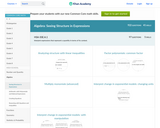
Activity for HIST 1301: United States History I (Module 5)
- Subject:
- U.S. History
- Material Type:
- Activity/Lab
- Author:
- Jessica Herzogenrath
- Kaitlyn Ross
- Tanner Ogle
- Date Added:
- 09/27/2022

Activity for HIST 1301: United States History I (Module 5)

Activity for HIST 1301 United States History I (Module 5)

Activity for HIST 1301: United States History I (Module 6)

Activity for HIST 1301: United States History I (Module 7)

Activity for HIST 1301: United States History I (Module 8)

Activity for HIST 1301: United States History I (Module 9)

This course will focus for a large part on MOSFET and CMOS, but also on heterojunction BJT, and photonic devices.First non-ideal characteristics of MOSFETs will be discussed, like channel-length modulation and short-channel effects. We will also pay attention to threshold voltage modification by varying the dopant concentration. Further, MOS scaling will be discussed. A combination of an n-channel and p-channel MOSFET is used for CMOS devices that form the basis for current digital technology. The operation of a CMOS inverter will be explained. We will explain in more detail how the transfer characteristics relate to the CMOS design.

This site teaches Arithmetic with Polynomials and Rational Expressions to High Schoolers through a series of 4333 questions and interactive activities aligned to 26 Common Core mathematics skills.

This site teaches High Schoolers how to create equations through a series of 298 questions and interactive activities aligned to 5 Common Core mathematics skills.

This site teaches Reasoning with Equations and Inequalities to High Schoolers through a series of 5909 questions and interactive activities aligned to 36 Common Core mathematics skills.

This site teaches Structure in Algebraic Expressions to High Schoolers through a series of 3482 questions and interactive activities aligned to 26 Common Core mathematics skills.

On this page, we have offered syllabi, course readings, chapter-by-chapter discussion questions, key terms, quizzes, essay assignments, and exams to do just that. Individual instructors, of course, should always govern their own curriculum and be able to determine their own pedagogy. Rather than attempting to build a common curriculum, these resources are designed merely as a starting point. Like our text, they are licensed openly (CC-BY-SA): you are encouraged to use them, download them, distribute them, and modify them as you see fit. Moreover, The American Yawp is, as always, an evolving, collaborative project. We welcome the submission of additional teaching materials and feedback on existing material. If you have any ideas or resources you’d like to share, please contact the editors (Ben Wright for the first half, and Joseph Locke for the second) directly.

This short video covers many anatomical terms.

This lab manual was written for Anatomy & Physiology 2, a 200-level A&P course, at River Valley Community College. The course uses the OpenStax A&P textbook. The manual is intended to complement any text but does derive a good deal of its content from the OpenStax A&P textbook.

These materials are designed to supplement a year-long three-course sequence that uses OpenStax Anatomy and Physiology (https://openstax.org/details/anatomy-and-physiology).

An adapted and revised edition of the OpenStax Anatomy & Physiology (https://openstax.org/details/books/anatomy-and-physiology) with revised content and artwork, Open Oregon State, Oregon State University.
The first adapted version may be accessed at: Anatomy & Physiology (https://open.oregonstate.education/aandp1).

This manual is a guide for anatomy and physiology laboratory exercises. It includes dissection guidance with detailed images; instructions for physiology experiments including foundational content; and gross anatomy study guides for six body systems. Videos and tutorial links provide additional support.

This OER is a quick, hands-on lab that helps students explore the anatomy and function of angiosperm seeds. Topics such as seed anatomy and function, seed dormancy, and seed germination are addressed in this lab. This lab is intended to be used as instructional materials for biology teachers.Within this resource are instructions on required lab materials,an introduction to seed anatomy and function, an explanation of seed dormancy and germination, a seed diagram to label, and student exercises to assist in content mastery.

Assignment and discussion prompts for 100-level anthropology courses. Scoring criteria are included.

This is a collection of mini lectures created by anthropologists and those in conversation with anthropology as supplimental material to assist college and university instructors who were made to shift their courses online because of COVID19.For more information, see here.To contribute, please create an OER author account and send your name and OER registered email to AnthropologyTeaching@gmail.com.